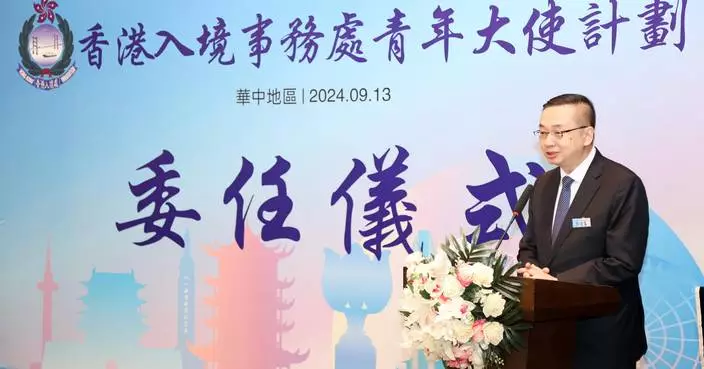HA approves implementation arrangements for Sale of Home Ownership Scheme Flats 2024
The following is issued on behalf of the Hong Kong Housing Authority:
The Hong Kong Housing Authority (HA)'s Subsidised Housing Committee today (August 27) approved the average selling prices and sales arrangements for the Sale of Home Ownership Scheme (HOS) Flats 2024 (HOS 2024) as well as the income and asset limits for White Form (WF) applicants.
"Apart from sparing no effort in constructing public rental housing to eligible applicants to shorten their waiting time, the HA has also been actively providing affordable Subsidised Sale Flats (SSFs) for purchase by the eligible applicants to fulfil their home ownership aspiration. Following the launch of HOS 2023 and the Sale of Green Form Subsidised Home Ownership Scheme Flats 2023 offering a total of about 12000 flats, the HA is going to launch HOS 2024 and start receiving applications in the fourth quarter of 2024," a spokesman for the HA said.
Details of the implementation arrangements for HOS 2024 are as follows:
Flats for sale
The HA will offer five new HOS developments with a total of over 7100 HOS flats, and a new batch of recovered Tenants Purchase Scheme flats under HOS 2024. While the number of new HOS flats put up for sale this time is slightly below the recent peak of about 9100 flats in HOS 2023, as some of the projects to be completed in the coming years have been put up for sale in previous sale exercises, it is still above the average number of around 6 900 flats for sale since the last few HOS sale exercises from 2018.
The new HOS developments are located at a wide variety of locations (including Kai Tak, Kwun Tong, Yau Tong, Tung Chung and Tuen Mun), providing choices of flats of different sizes with saleable areas ranging from about 17.3 square metres to about 47.4 sq m (about 186 square feet to about 510 sq ft), catering for the needs of different applicants. Large flats, with saleable areas ranging from about 41.1 sq m to about 47.4 sq m (about 442 sq ft to about 510 sq ft), have been more popular among applicants and account for about a quarter of the total number of flats. (See Annex 1)
Pricing
The HA continues to price HOS flats at an affordable level. The average selling prices of the HOS flats for sale under HOS 2024, if setting the selling prices at an affordable level, are set at a 30 per cent discount from the current assessed market values (i.e. for sale at 70 per cent of the assessed market values). The selling prices of flats in the five new HOS developments range from $1.43 million to $4.67 million with an average selling price of about $2.7 million.
"Based on the average flat selling price at about $2.7 million with the assumption that the mortgage loan-to-price ratio is 90 per cent and the flat is mortgaged for a term of 30 years at an interest rate of about 4 per cent, mortgage payment is only about $11,600 per month. For one to two-person flats, the average selling price is about $1.7 million and the mortgage payment is only about $7,300 per month, which will be welcomed by young families and young people," the spokesman said.
Priority for flat selection and quota
The HA will implement the Families with Newborns Flat Selection Priority Scheme (Priority Newborns Scheme) announced under The Chief Executive's2023Policy Address as scheduled. A quota of about 40 per cent of the new flats to be offered for sale under HOS 2024 will be set for balloting and priority flat selection by those eligible applicants applying under the Priority Newborns Scheme and Priority Scheme for Families with Elderly Members (Priority Elderly Scheme). Family applicants of SSFs sale exercises with babies born on or after October 25, 2023, will be eligible if their babies are aged 3 or below on the closing date of the application of HOS 2024.
The HA will also refine the arrangements of quota allocation at the same time. In the past, the quota is set according to the total number of flats in all developments under a sale exercise. To provide applicants of different application categories a reasonable chance to purchase flats in different developments, the HA has decided to set the quota on a project-by-project basis according to the respective number of flats in individual new HOS developments. In each development, the quota for the Priority Newborns Scheme and the Priority Elderly Scheme is 40 per cent of the number of flats of the development, and the quota for one-person applicants is 10 per cent of the number of flats of the development. The order of priority for flat selection by eligible applicants will be determined by the application category, quota allocation and ballot results. (See Annex 2)
White Form income and assets limits
At the same time, the HA has also reviewed the WF income and asset limits according to the established mechanism. For family applicants with a household size of two persons and above, the income limit was reduced from $62,000 per month to $60,000 per month, and the asset limit was reduced from $1.47 million to $1.23 million, making downward adjustments of 3.2 per cent and 16.3 per cent respectively. For one-person applicants, their income and asset limits were reduced to $30,000 per month and $615,000 correspondingly.
Since the income and asset limits for HOS application are based on citizens' ability to afford home ownership in the private sector, the WF income and asset limits shall be slightly reduced in response to the development of the private property market of Hong Kong.

Source: AI-generated images
CHP appeals for heightened vigilance against invasive Group B Streptococcus
The Centre for Health Protection (CHP) of the Department of Health today (September 13) appealed to members of the public for heightened vigilance against invasive Group B Streptococcus and in particular, urged them to pay attention when touching or handling raw freshwater fish and should wear gloves, as well as not to consume undercooked freshwater fish.
Hong Kong has recorded in 2021 summer (between September and October) a cluster of more than 50 cases of Group B Streptococcus, belonged to serotype III sequence type 283 (ST283). The then investigation found that the infections were associated with contact of raw freshwater fish or consumption of undercooked freshwater fish. The CHP subsequently enhanced surveillance on the relevant cases with the Hospital Authority (HA). The recent surveillance data revealed an upward trend in the number of in-patients tested positive for invasive Group B Streptococcus during last month and September 11. The CHP immediately conducted further laboratory analysis of the cases in collaboration with the HA and the preliminary result showed that 27 of the cases were ST283. The CHP's analysis of some of the samples is still in progress and it cannot rule out that the number of cases will further increase.
The CHP's epidemiological investigations showed that the 27 patients with ST283 infections involved ten males and 17 females, aged between 53 and 88 (median: 70), residing in 18 districts throughout the territory, with no district clustering identified. Among them, 20 patients have underlying illness. The patients mainly presented with sepsis (15 patients), joint abscess (nine patients), meningitis (two patients) and urinary tract infection (one patient). The HA's information showed that among the 27 patients, five have been discharged, 17 hospitalised patients are in stable condition, three in serious condition and the other two passed away. The CHP is obtaining further information on the cause of death from HA.
The CHP also conducted an in-depth investigation on the exposure history of individual patients prior to the onset of the disease in order to identify the possible sources of infection. It was found that about 90 per cent of the patients had contact with or handled raw freshwater fish, prior to the onset of their disease. Seven of them reported that they had wounds on their hands when handling raw freshwater fish, but no infected person reported that they had consumed freshwater fish sashimi. Based on the above information, the CHP considered that the cause of infection was related to the handling of or contact with raw freshwater fish (especially with wound on the hands).
In addition, investigations revealed that 19 patients had been to freshwater fish stalls in markets and contacted freshwater fish, which involved 14 markets located in different districts. The personnel of the CHP had inspected markets where some of the patients had visited and wholesale fish markets supplying live fish to conduct epidemiological investigations. A total of 71 relevant workers have been monitored and no symptomatic worker found. The CHP has provided health education to the workers and will continue to monitor health conditions of workers of other fish stalls. During the investigations, it was identified that the ST283 isolates of environmental and fish samples collected from a retail freshwater fish stall inside the Shek Wu Hui Market is identical to those found in some patients. For prudence's sake, the Food and Environmental Hygiene Department (FEHD) has arranged thorough cleansing and disinfection for all freshwater fish stalls inside Shek Wu Hui Market. The investigations of the CHP are ongoing.
The CHP, the FEHD and the Agriculture, Fisheries and Conservation Department (AFCD) held a joint meeting today to review the relevant situation. The FEHD's personnel will inspect all fish stalls, licensed Fresh Provision Shops and Permitted Premises selling freshwater fishin Hong Kong, provide education on hygiene to relevant workers and request them to strengthen cleaning and disinfection work at the premises. The FEHD conducts thorough cleaning at each public market every day and will pay special attention to the hygiene condition in the vicinity of freshwater fish stalls in the markets. Separately, the AFCD confirmed no abnormality has been observed regarding freshwater fish in wholesale fish markets and will continue to monitor the condition of live fish.
"Literature reported that ST283 exists in freshwater fish, especially in Southeast Asia countries, and with seasonal pattern. Association between invasive Group B Streptococcal infection of ST283 and consumption of raw freshwater fish was also reported in overseas literature," a spokesman for the CHP said.
"Members of the public shall wear gloves when touching or handling raw freshwater fish. If symptoms such as inflamed wound and fever develop, they should seek medical attention promptly. Meanwhile, the public should refrain from consuming undercooked freshwater fish," a spokesman for the CHP reminded.
The CHP will issue a letter to doctors to enhance their alertness for Group B Streptococcus infection cases. The CHP will continue to provide advice to members of the public through different channels to minimise the infection risk and work together with relevant departments to enhance publicity, especially health education related to wound care and consumption of freshwater fish.
A spokesman for the FEHD said that in order to protect public health, freshwater fish sashimi is a prohibited food item under the Food Business Regulation (Cap. 132X) in Hong Kong.
To prevent Group B Streptococcus (ST283) infection, members of the public are reminded to maintain personal, food and environmental hygiene and should keep their hands clean and practice good wound care at all times, especially:
To minimise the infection risks, workers of aquatic products or restaurants must wear gloves when handling aquatic products and avoid direct contact with aquatic products or dirty water with bare hands;
When buying aquatic products, the public must avoid direct contact with the aquatic products or use any towel provided by the stalls. They should wash hands with liquid soap and water as soon as possible if having contact with aquatic products which are not fully cooked. When handling aquatic products at home, the public should also wear gloves and wash hands thoroughly afterwards;
Members of the public must not eat any freshwater fish sashimi, raw or undercooked freshwater aquatic products. When consuming hot pot food or congee items which consist of aquatic products, they should ensure that the food is thoroughly cooked in which the centre of the food should reach a temperature of at least 75 degrees Celsius so as to destroy pathogen; and
People must not touch aquatic products directly whenever there is a wound on hands. If a wound is sustained during handling aquatic products, the wound must be cleaned immediately and properly covered with waterproof adhesive dressings. Individuals should seek medical advice promptly when wound infection is found.
The public may visit the CHP's Invasive Group B Streptococcus Infection associated with Sequence Type 283 (ST283) page for more information.

Source: AI-generated images










